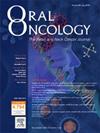Implication of circulating miRNAs as potential diagnostic biomarker in oropharyngeal squamous cell Carcinoma: Association with Human Papilloma Virus
IF 4
2区 医学
Q1 DENTISTRY, ORAL SURGERY & MEDICINE
引用次数: 0
Abstract
Background
Over the past decades, significant progress has been made in the early diagnosis and treatment of oropharyngeal squamous cell carcinoma (OPSCC). However, the survival rate has not improved. Human papillomavirus (HPV) is a major risk factor for the development of oropharyngeal cancer. Therefore, understanding the molecular mechanisms underlying OPSCC may help define improved diagnostic and prognostic strategies. Previous studies on tissue samples have linked microRNAs (miRNAs) to the progression of OPSCC. This study aimed to develop a panel of diagnostic biomarkers based on the serum miRNA signature in OPSCC that correlates with HPV status.
Materials and Methods
Paired serum and tissue samples were collected from 30 OPSCC patients and 20 healthy controls. Based on previous studies on OPSCC tissue samples, a set of six miRNAs (miR-93, miR-222, miR-199, miR-320, miR-145, and miR-126) was selected due to their association with OPSCC development and progression. RT-qPCR was used to compare miRNA expression in paired samples, with miR-16 serving as the reference gene for normalization. Receiver operating characteristic (ROC) curve analysis was performed to evaluate the diagnostic potential of these serum miRNAs.
Results
The mean relative fold change for serum miR-93 and miR-222 was upregulated, whereas miR-199, miR-320, miR-145, and miR-126 were downregulated in OPSCC compared to normal controls. A similar trend of upregulation and downregulation was observed in tissue samples. The mean relative expression of miR-93 was significantly associated with HPV status (p < 0.0001). Additionally, the mean relative expression levels of all six miRNAs (miR-93, miR-222, miR-199, miR-320, miR-145, and miR-126) were significantly different between the serum of normal controls and early-stage OPSCC patients. The serum miRNA panel, including miR-93, miR-222, miR-199, miR-320, miR-145, and miR-126, demonstrated significant diagnostic potential in distinguishing OPSCC from normal controls.
Conclusion
Our findings suggest that a panel of OPSCC-related miRNAs demonstrates concordant expression levels in serum and tissue of OPSCC, and may serve as a minimally invasive diagnostic biomarker for OPSCC. Further studies with a larger sample size are needed to confirm these findings, particularly in HPV-associated OPSCC.
循环mirna作为口咽鳞状细胞癌潜在诊断生物标志物的意义:与人乳头瘤病毒的关联
在过去的几十年里,口咽鳞状细胞癌(OPSCC)的早期诊断和治疗取得了重大进展。然而,存活率并没有提高。人乳头瘤病毒(HPV)是发展口咽癌的主要危险因素。因此,了解OPSCC的分子机制可能有助于确定更好的诊断和预后策略。先前对组织样本的研究已经将microRNAs (miRNAs)与OPSCC的进展联系起来。本研究旨在开发一组基于与HPV状态相关的OPSCC血清miRNA特征的诊断生物标志物。材料与方法采集30例OPSCC患者和20例健康对照者的血清和组织标本。基于先前对OPSCC组织样本的研究,由于miR-93、miR-222、miR-199、miR-320、miR-145和miR-126与OPSCC的发展和进展相关,我们选择了一组6个mirna (miR-93、miR-222、miR-199、miR-145和miR-126)。采用RT-qPCR比较配对样本中miRNA的表达,miR-16作为标准化的内参基因。采用受试者工作特征(ROC)曲线分析来评估这些血清mirna的诊断潜力。结果与正常对照组相比,OPSCC患者血清miR-93和miR-222的平均相对折叠变化上调,而miR-199、miR-320、miR-145和miR-126下调。在组织样本中也观察到类似的上调和下调趋势。miR-93的平均相对表达量与HPV状态显著相关(p <;0.0001)。此外,所有六种mirna (miR-93、miR-222、miR-199、miR-320、miR-145和miR-126)的平均相对表达水平在正常对照和早期OPSCC患者血清中存在显著差异。血清miRNA面板,包括miR-93、miR-222、miR-199、miR-320、miR-145和miR-126,在区分OPSCC和正常对照方面显示出显著的诊断潜力。结论一组与OPSCC相关的mirna在OPSCC的血清和组织中表达水平一致,可能作为OPSCC的微创诊断生物标志物。需要更大样本量的进一步研究来证实这些发现,特别是在hpv相关的OPSCC中。
本文章由计算机程序翻译,如有差异,请以英文原文为准。
求助全文
约1分钟内获得全文
求助全文
来源期刊

Oral oncology
医学-牙科与口腔外科
CiteScore
8.70
自引率
10.40%
发文量
505
审稿时长
20 days
期刊介绍:
Oral Oncology is an international interdisciplinary journal which publishes high quality original research, clinical trials and review articles, editorials, and commentaries relating to the etiopathogenesis, epidemiology, prevention, clinical features, diagnosis, treatment and management of patients with neoplasms in the head and neck.
Oral Oncology is of interest to head and neck surgeons, radiation and medical oncologists, maxillo-facial surgeons, oto-rhino-laryngologists, plastic surgeons, pathologists, scientists, oral medical specialists, special care dentists, dental care professionals, general dental practitioners, public health physicians, palliative care physicians, nurses, radiologists, radiographers, dieticians, occupational therapists, speech and language therapists, nutritionists, clinical and health psychologists and counselors, professionals in end of life care, as well as others interested in these fields.
 求助内容:
求助内容: 应助结果提醒方式:
应助结果提醒方式:


